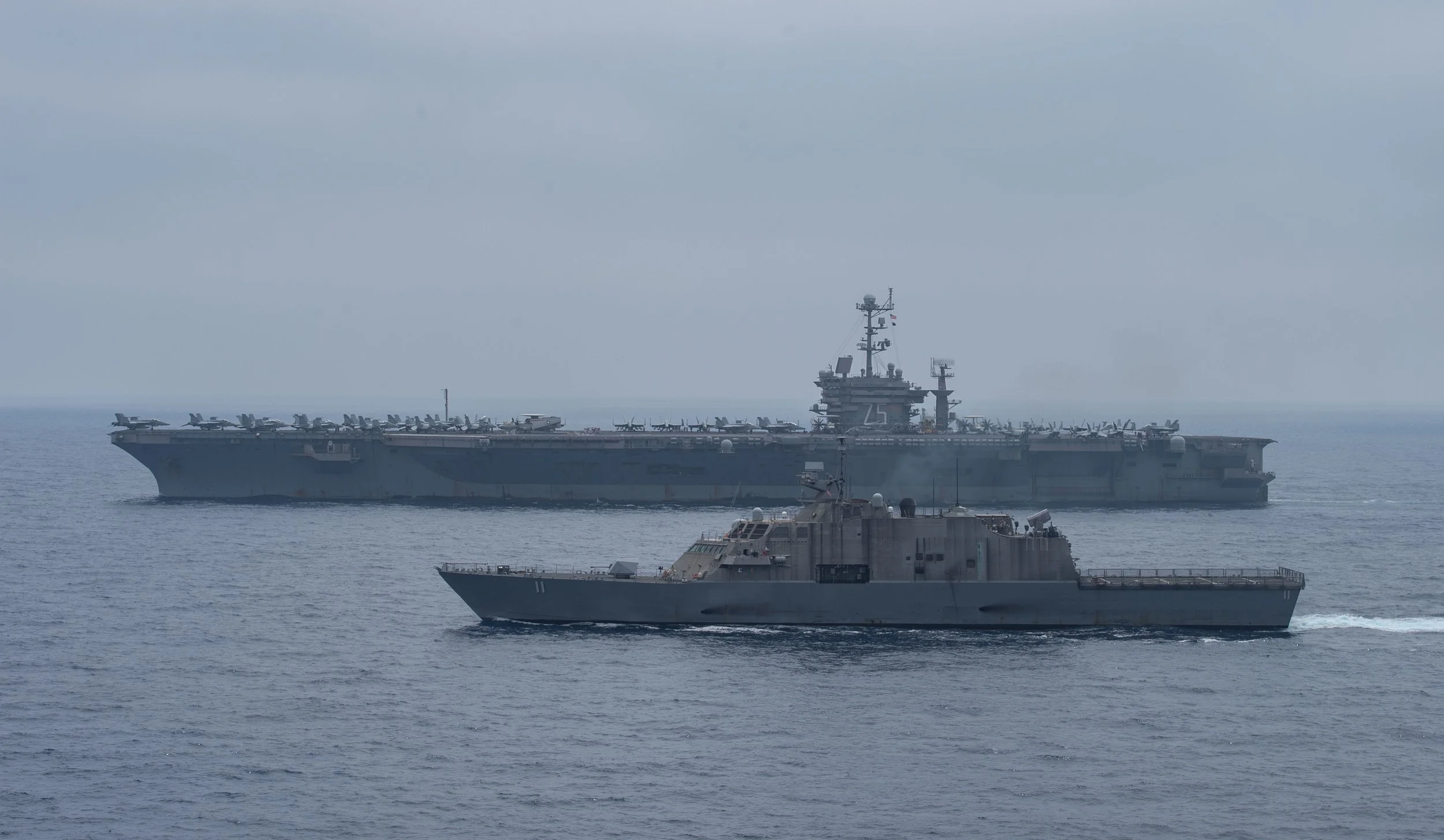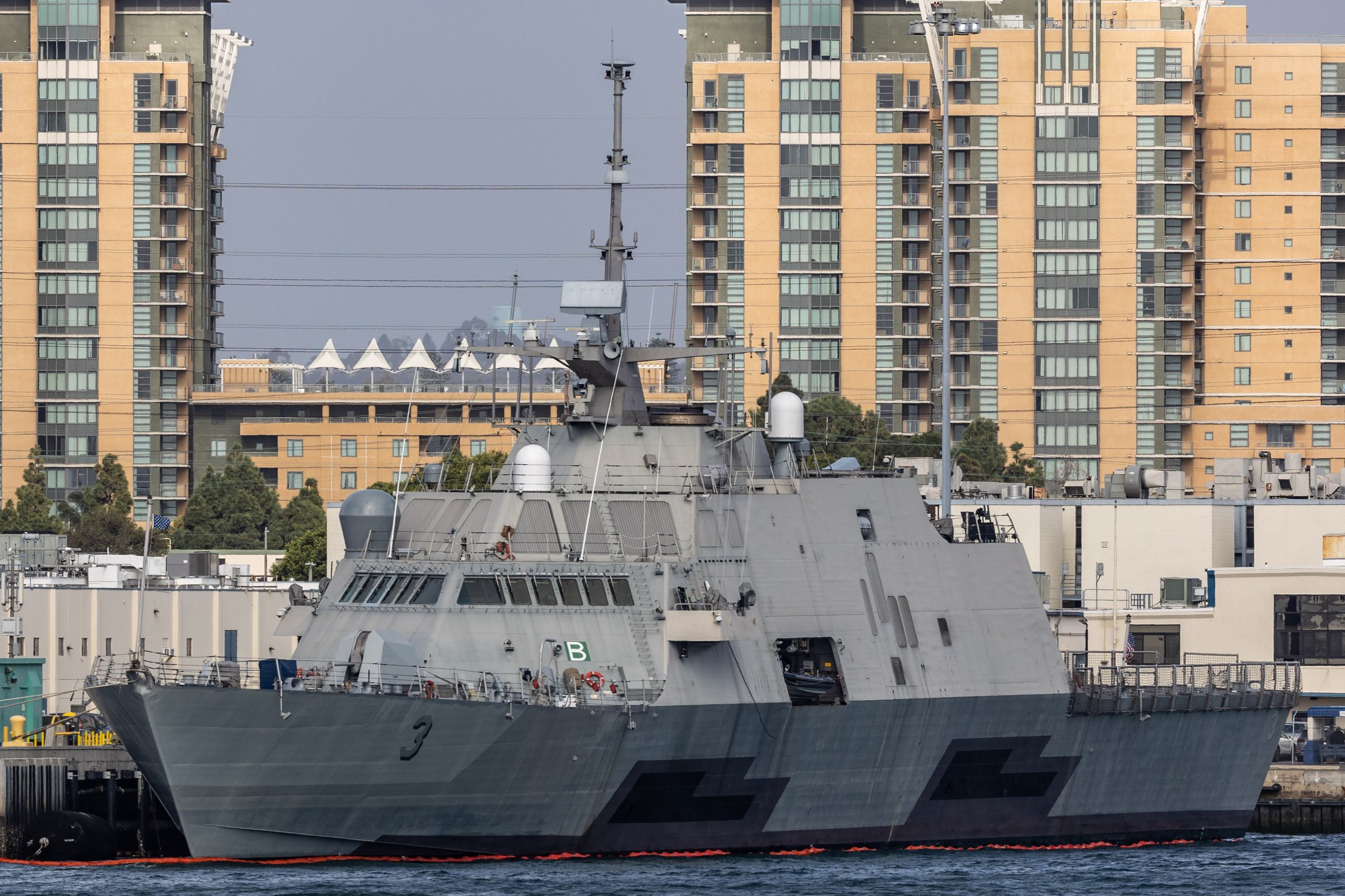June 22, 2022 5:46 PM
The Freedom-variant littoral combat ship USS Sioux City (LCS 11), front, transits the Tyrrhenian Sea alongside the Nimitz-class aircraft carrier USS Harry S. Truman (CVN 75) on May 16, 2022. US Navy Photo
The House Armed Services Committee on Wednesday approved an amendment that would authorize a $37 billion increase to the annual policy bill’s topline and save five Littoral Combat Ships from decommissioning.
The amendment, proposed by Reps. Jared Golden (D-Maine) and Elaine Luria (D-Va.), would authorize $1.2 billion for the Navy to buy another Arleigh Burke-class destroyer and allow the service to use incremental funding for the purchase. It would also authorize $923.8 million for another Constellation-class frigate, $746 million for another T-AO-205 John Lewis-class oiler and $695 million for two Expeditionary Medical Ships. These ships would be in addition to the eight battleforce ships the panel’s mark already authorizes to meet the Navy’s Fiscal Year 2023 budget request.
The HASC’s markup of the FY 2023 policy bill is ongoing as of this posting.
Golden’s and Luria’s amendment also authorizes $660 million for eight F/A-18E/F Super Hornet, despite Navy efforts to end the Boeing fighter line. It authorizes $400 million for the Navy to buy two more E-2D Advanced Hawkeyes, $446.2 million for three Navy C-130s, $252.9 for two more Marine Corps KC-130Js, $250 million for two more Marine Corps CH-53K King Stallion heavy-lift helicopters and $212 million for two V-22 Ospreys.
The amendment also authorizes $318 million in funding to save five of the nine Littoral Combat Ships the Navy sought to decommission in its FY 2023 proposal and another $59 million to save two Expeditionary Transfer Docks. The HASC chairman’s mark notably did not stop the Navy from retiring any of the LCSs.
The potential decommissioning of the Littoral Combat Ships has been a prominent discussion topic throughout debate of the FY 2023 defense spending and policy bills. The Navy’s budget proposal sought to decommission a total of 24 ships in FY 2023, including nine Freedom-class LCSs.
Luria’s and Goldman’s amendment follows the same moves by the Senate Armed Services Committee and the House Appropriations defense subcommittee. SASC in its mark of the defense policy bill saved five of the nine LCSs up for decommissioning, as did HAC-D in its mark of the annual defense spending bill.
But some lawmakers opposed saving the LCSs from early decommissioning. During Wednesday’s markup of the HASC chairman’s mark of the FY 2023 policy bill, Rep. Jackie Speier (D-Calif.) displayed a chart labeling the LCSs as “Leaking Cracked Ships,” as she spoke in opposition to keeping the ships in the fleet.
“We all know what lemon cars are. We have a fleet of lemon LCS ships. We have spent billions of dollars on this fleet when they have no capability to help us deal with [what] our largest threat is, which is that of China and Russia. The only winners have been the contractors on which the Navy relies for sustaining these ships,” Speier said.
Freedom-variant littoral combat ship USS Milwaukee (LCS-5) departs Naval Station Guantanamo, Jan. 3, 2022. US Navy Photo
“The Freedom-class has been plagued by reliability issues from the start, with numerous power and engine failures, including 10 out of the 11 deployments that the [Government Accountability Office] examined. They’ve got problems with the gears that are faulty. I mean, it goes on and on,” she added.
Listing off problems various Freedom-class hulls have faced, Speier called the ships “a sunk cost” and argued the Navy should not spend millions to keep them in the fleet because they are prone to breaking down.
The Freedom-class ships have faced two significant problems: a class-wide issue with the combining gear that marries the gas turbines to its diesel engines and an inability to field the anti-submarine warfare package for the LCS Mission Module. The Navy earlier this year said it would scrap the ASW package for the LCS due to issues fielding Raytheon’s AN/SQS-62 variable depth sonar (VDS) on the Freedom hull.
HASC Chairman Adam Smith (D-Wash.) similarly spoke in opposition to Golden’s and Luria’s amendment, but praised the package for going after inflation and modernization. The chairman reiterated his argument that the quality of platforms matters more than the quantity of platforms.
“However one feels about the LCS, there have been some arguments that have been made that I just find deeply troubling. One is, ‘well we already bought them, so why would we decommission them?’ Good money after bad is about as cliché as it gets. But it is really important at this point … we have to pay to operate these things,” Smith said.
“And they consistently break down and they consistently have incredibly high maintenance costs,” he added. “So we’re paying money and we’re not getting much in the way of capability. We can save that money, spend it on other things that actually are capable.”
Prior to the amendment’s passage, Smith said he planned to introduce an amendment about the five LCSs on the House floor so the entire chamber could debate the topic.
The Navy’s effort to decommission the LCSs has been fraught, with some lawmakers criticizing plans to retire relatively young ships that have not reached the end of their service lives.
Rep. Rob Wittman (R-Va.), the ranking member of the HASC seapower and projection forces subcommittee, told USNI News in an interview this week that while he does not support getting rid of a large number of the LCSs because the class has faced some problems, he thinks the Navy should evaluate potential Foreign Military Sales and how partners or allies could use the ships.
“I do think that those ships have utility both for our Navy and our service branches, but also in ways that could really build United States strategic relationships with other nations,” Wittman said.
Should the U.S. transfer or sell the ships to other countries, Wittman argued there should be a military-to-military relationship between the U.S. and those nations so the U.S. Navy could train those sailors to both use the ships and exercise with them.
“I want to make sure too that we exhaust every possibility for us in our military,” he said.
Wittman pointed to the potential for the U.S. Marine Corps to use the LCS to move Marines around and for the U.S. Coast Guard to use them to perform counter-drug operations in U.S. Southern Command. He said the Coast Guard likely wants more National Security Cutters and the LCS could fulfill that mission set.
“This would be a great opportunity for the Coast Guard to be able to take a ship that has the capability I think that they would need – can move quickly, has the ability to deploy an 11-meter [rigid-hull inflatable boat]. Those are things that fit right within the Coast Guard mission,” Wittman said.
“And the same for the Marines. I mean, the ability to move Marines back and forth – to do tactical support – this ship has some ability to do tactical support for Marines ashore. I think all those things are missions that would fit easily with LCS without any major modifications to it,” he continued. “So I think we need to exhaust all of those possibilities as we go down this road, and then if all of those are exhausted, then we can talk about [Foreign Military Sales]. But FMS does have to be part of the conversation.”
During May testimony before the Senate Appropriations Committee, Chief of Naval Operations Adm. Mike Gilday floated the potential to transfer the LCSs to other countries.
The House Appropriations defense subcommittee in its draft of the FY 2023 spending bill called for a report analyzing other uses for the LCSs and specifically said the Navy could decommission four of the hulls that it could then assess for transfers to other countries.
Meanwhile, the House Appropriations Committee on Wednesday marked up and passed its defense spending bill, which met the Biden administration’s request and allotted $762 billion in defense spending.
USS Fort Worth (LCS-3) pier-side at Naval Station San Diego, Calif., on Feb. 15, 2022
Rep. John Rutherford (R-Fla.), a member of HAC whose district includes Naval Station Mayport – where the Freedom-class LCSs are based, – proposed and then withdrew an amendment that would have saved all nine LCSs from decommissioning.
“It is complete financial malpractice, Madam chair, to scrap any of these ships that have barely begun their service life. They’ve barely begun,” he said.
“The average years of service is less than four years, four years. That’s less than one quarter of their expected 25-year lifecycle. Taxpayers have already spent $4.5 billion on building out the LCS class. It is just wasteful to throw away these decades of investment,” Rutherford added.
Rep. Betty McCollum (D-Minn.), who chairs the House Appropriations defense subcommittee, said Wednesday that she has spoken with the Navy about its proposal for the LCSs.
“The first round of discussions I had with the Navy were very unsatisfactory. And they’re coming around to see the seriousness of us making sure that the taxpayers dollars that have been invested are at a minimum repurposed in a way that helps with our national security,” she said during the markup.
While House appropriators followed the Biden administration’s request, Senate authorizers last week authorized a $45 billion increase to the defense topline.
“I think this $37 billion is a start. I applaud the Senate for their addition of $45 billion,” Luria said Wednesday during the HASC markup.
“I know we have slightly different priorities and throughout this process I hope we will end up with an agreement somewhere north of this $37 [billion]. But I think adding this to the budget at least for me makes this NDAA acceptable in its overall topline.”
HASC on Wednesday also approved a separate amendment proposed by Rep. Jim Cooper (D-Tenn.) to authorize $45 million in research and development funding for the low-yield Sea-Launched Cruise Missile. The Biden administration sought to cancel the program in the FY 2023 budget proposal, but Congressional authorizers have sought to approve research and development funding for the program. SASC similarly authorized research and development funding for SLCM in its draft of the policy bill.




